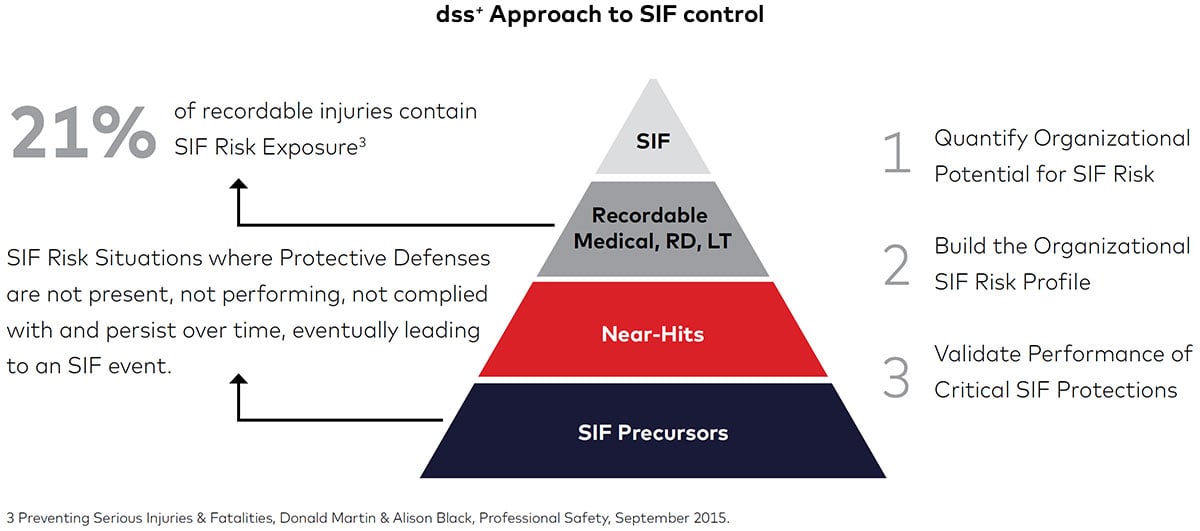dss+ Approach to Serious Injury & Fatality (SIF) Control – Part 1 of 3
According to the U.S. Bureau of Labor Statistics, while workplace injury rates have been declining, fatalities are not. In 2009, the fatal injury rate was 3.5, and 10 years later in 2018, the fatal injury rate remained unchanged at 3.5 per 100,000 FTEs. Given this alarming trend, organizations need to have a comprehensive plan developed and in place to identify, remedy, and reduce Serious Injury and Fatality (SIF) risks in their operations so they can protect their people, productivity, and business performance. Such a plan needs to focus on risks that can lead to acute, instantaneous events with acute, instantaneous consequences that are potentially life-threatening, life-altering, or fatal. This SIF risk white paper #1 details the key first steps to take to improve SIF risk.

What Do You Really “Know” About Your Company’s SIF Risk Potential?
There is one scenario that every operations executive or senior safety leader hopes they never experience: It is the middle of the night, and you are awakened by the ringing of your telephone. You fear the worst as you answer the call, and the voice on the other end confirms your deepest dread. A seemingly random, unpredictable fatal accident has occurred on your watch. One of your fellow employees has lost his or her life, and your mind races knowing that you must face their loved ones who will be demanding answers.
Regrettably, this terrible scenario is just as likely to occur today as it was in years past. According to the U.S. Bureau of Labour Statistics, while injury rates have been declining, fatalities are not. In 2009, the fatal injury rate was 3.5 and ten years later in 2018, the fatal injury rate remains unchanged at 3.5 per 100,000 full-time equivalent workers.1
Given this alarming trend, organizations need to have a comprehensive plan developed and in place to identify, remedy and reduce Serious Injury and Fatality (SIF) risks in their operations so they can protect their people, productivity and business performance. Such a plan needs to focus on risks that can lead to acute, instantaneous events with acute, instantaneous consequences that are potentially life-threatening, life-altering or fatal.2
Developing such a comprehensive SIF plan begins with answering three fundamental questions:
- Can I quantify my organization’s potential for SIF risk?
- What specific SIF risks do my workers face each day?
- How do I know for certain if the SIF protections and deferences for each of these SIF risks are in place and performing as intended, truly protecting my people?
Quantifying Organizational Potential For SIF Risk
Many organizations are fully aware of their recordable injury rates, lost-time frequency, and workers' compensation costs. But very few companies have attempted to quantify their level of exposure to SIF risk. This is important because reliance on the aforementioned lagging indicators allows leaders to draw misleading conclusions on the level of SIF risk control. How often have we heard leaders make the following statement, and then experience a fatal or near-fatal workplace accident? “My recordable injury rate has been improving steadily for 10 years and is now below 0.3. We haven’t experienced any fatalities during that decade. Therefore, our SIF risk must be under control”. As organizational leaders, we must develop more reliable evidence to determine the effectiveness of our SIF control efforts.
Here are four steps for developing a more valid view of the level of exposure to SIF risk.
-
Develop SIF definitions and a calibrated decision logic for reliable and accurate binary determination of the presence of SIF Risk, based on the incident context (it’s either present or not present). Keep in mind there are many “potentials” and few “actuals”, so the decision rules for classification must be designed to look for incidents with SIF Risk Potential. The only real difference between an “actual SIF” and a “potential SIF” in inches, seconds, and luck. Each should receive the same treatment.
-
Apply this decision logic while conducting a longitudinal analysis of a representative sample of recordable injuries and near-misses. By closely examining the case narratives, root causes and contributing factors, and the corrective and preventive actions (CAPA), you will see the history that emerges. This examination will enable you to identify the facts, evidence, and data necessary to reveal the evident SIF patterns and trends. By focusing on these three categories, you can extract significant meaningful information from those events with SIF risk.
-
Build a Pareto Analysis of SIF Risk situation frequency. Focus on the specific situations where workers are performing their jobs. This context is important as it forms the framework for the SIF Decision Logic Tree. Conduct a similar Pareto for root causes/ contributing factors, and CAPA’s.
-
Calculate and visually display your % SIF Exposure Risk as a SIF triangle inside the Incident Triangle. Display the root causes/contributing factors and CAPA analysis in a visually appealing chart that quickly conveys the key points of the data distribution. These visual displays capture executive attention and make it easier to engage others in meaningful conversations about SIF risk.

Specific SIF Risks Faced Daily - the Organizational SIF Risk Profile
Now that you’ve quantified the level of SIF risk in the organization, how can you determine with more specificity where these SIF risks are present, how frequently they are encountered, and what defences must be in place for 100% protection? Even though there are only two major steps to this process, this is a resource-intensive and time-consuming activity. Diligent attention must be paid to the execution of this step because it gets to the heart of the SIF risk control problem. This two-step process will ultimately result in the identification of the behaviour and conditions that must be in place to protect the lives of your workers. These are considered “safety absolutes” and “no exceptions”.
-
Conduct an inventory of SIF situations per shift per day per site. This is a SIF risk frequency profile. Use the SIF Decision Logic Tree (describing most frequently occurring SIF situations) as the source document. Gather frequency data directly from the source where possible. That is, speak directly with operations and maintenance personnel who work within the process. You cannot realistically estimate risks without involving the people doing the work.
-
Identify the critical SIF Protection controls/defences/measures that must be in place and functioning without fail to ensure that no life is in jeopardy. To solve the SIF risk control problem, this must be done for each specific task with known SIF risk. These should be placed on job-specific SIF Risk Control Checklists. These checklists will enable on-the-ground SIF Protection Validation (SIF-PV), described in the next section.
“Knowing for Certain” - Validating Performance of Critical SIF Protections
Now that you know where SIF risk is present, and what behaviours and conditions must be fully met to provide complete protection, it is time to go out to action and validate exactly what’s happening in the real world. You must see with your own eyes and hear with your own ears what’s actually happening on the ground. A trained observer/interviewer with a calibrated SIF Risk Control Checklist (developed in the previous step) goes to the job site and collects objective data. They’ll record what they see and hear, and provide feedback to the worker/crew. These observations/interviews can be conducted by managers, executives, supervisors, safety professionals, and front-line workers. Getting this process started requires the following steps.
-
This should not be a random activity. Plan site visits to work with Job Schedulers and Planners who are reliable sources for anticipating jobs/tasks with SIF risk that are “on the schedule”. Plan site visits accordingly.
-
Conduct SIF Protection Validations (SIF-PV) via targeted sampling of SIF Risk Situations, observing and interviewing crews and individual workers. Observing, interviewing, and listening skills are a prerequisite for anyone conducting these on-the-ground performance validations of SIF protective defences. Feedback conversations will build worker SIF risk awareness, which is critical to performing work safely.
-
The SIF-Protection Validation (SIF-PV) process is designed to seek answers to the following questions:
- Are our critical SIF protections absent or present?
- If present, is the control performing as intended, and truly protecting the worker?
- If absent or deficient, why is the control missing or not performing as intended?
- The job must be stopped, and the SIF Protection put in place before the job is allowed to continue. The absence or non-performance of a critical SIF defence, by definition, means that the worker’s life is in jeopardy.
- Does the crew, worker, and supervisor understand the SIF risk they are facing?
- Do they understand the critical nature of the SIF protections that must be in place and functioning to protect their lives?
- Are they willing, and have they demonstrated the highly desirable behaviour of stopping/pausing the job if a SIF protection is missing (on their own), and the same for reporting a near-miss/close-call with SIF risk?
-
Data on the observation and interview is collected and entered into the SIF risk data register for assessment and detection of patterns or trends requiring action. This information is communicated to the sponsoring executive team and informs the metrics on the SIF dashboard.
Conclusion
Each of these steps must be grounded in facts. For that, an effective data collection and analysis tool are critical. A key to success includes thinking ahead about these required elements: data design (quality of case narratives, variables), data capture (accurate, consistent, reliable), and data assessment (meaningful, actionable information). It’s undeniably important to build these features into your SIF prevention process.
Done well, leaders will have better insights into SIF risk, and workers will be enabled to make better decisions to control and reduce their SIF risk. Organizations with benchmark performance own SIF Prevention and integrate it into the cultural fabric of their organizations. Evidence of this commitment is seen through behaviours at every level of the organization and includes:
- Reporting of near-misses, especially those with SIF risk.
- Improving pre-shift safety tailboards to accurately predict SIF risks that will be encountered, implementation of all critical controls before work begins, and identification of triggers for pausing work.
- The actual exercise of pause-work when sufficient SIF protections are not present, or when the SIF risk profile changes.
- After-action reviews to critique the effectiveness of SIF risk recognition and control.
- Upstream work planning and scheduling anticipates SIF risks and builds defence measures into the work plan.
- Conducting on-the-ground SIF-PVs becomes leader/manager standard work.
- SIF-leading metrics become part of the routine executive agenda and drive executive conversations in safety.
Many more elements are required for an effective SIF prevention process, one that delivers sustainable results. We’ll cover other aspects in future papers. The elements described in this framework document are the first steps toward building a more mature approach to SIF prevention.
As a leader, you want all of your people fully protected from SIF risk, all of the time. You want to know with certainty if you have any SIF vulnerabilities. Most importantly, you want assurances that everyone in the organization recognizes SIF risks and understands the importance of validating the controls necessary for protection. Following this proven pathway will provide the essential framework for operations executives and safety leaders to improve their organizational SIF performance.
Ultimately management is responsible for SIF risk reduction. By fostering a SIF risk control mindset, leaders can help their organizations become more proactive with far-reaching impacts beyond safety.
| This paper, “What Do You Really Know About Your Company’s SIF Risk Potential?” is one in a series of three articles written by dss+ discussing how companies can develop a comprehensive SIF risk reduction plan for their organizations. In the next article of this series, dss+ addresses effective implementation of a SIF intervention program. The third and final article in the series covers governance and oversight of an organization’s SIF program. |